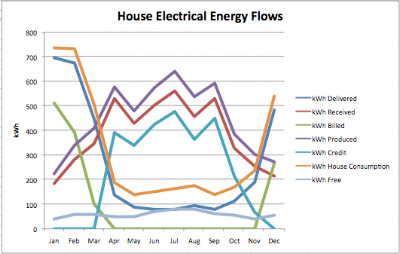Continuation description of a near zero energy house construction. See wolfgershouse for first part.
Thursday, December 27, 2012
Finally a Zero Energy House
I have now lived a complete year with my 4.5 kW solar PV array powering my house and Green Mountain Power Co. (GMP) and receiving from GMP electricity when I needed it. It was an exceptionally sunny and mild year in Vermont which made it easier to be energy positive for the year. Since the house is all electric, it's relatively easy to observe the energy flows as recorded by GMP on 3 meters as shown in the graphic.
When monthly readings are entered into a spreadsheet, this chart is generated, showing the monthly variations.
From the sum of the monthlies,
Total house consumption = 3877 kWh
Solar Production = 5325 kWh ( $0.06/kWh)
Energy delivered by GMP = 3173 kWh ($0.147/kWh)
Energy delivered to GMP = 4621 kWh ($0.147/kWh)
Free Energy = 704 kWh ($0/kWh)
it is observed that the house energy production far exceeded the total house consumption.
It should be noted that the house temperature in winter is set at 65 degF and that on sunny days the temperature in midwinter will rise to about 68 degF. On cloudy days, the electrical heat is supplemented by a little wood stove heat. Typically 4 pieces at around 14 lbs, burning for about two hours (14 lbs * 6000 BTU/lb * 0.63 (stove efficiency) = 53000 BTUs or ~15.5 kWh) is more than sufficient to raise the temperature on a 10 deg day to over 70 deg. This past year I burned around 1/4 cord of wood adding an extra approx. 1000 kWh of heat. Even with this extra heat, I still produced more than I consumed. Of course, a cloudy and colder next year may make the year's energy balance negative.
So how cold was it in 2012? A measure of heating needed for the year is the heating-degree days experienced here in Vermont. Weatherdatadepot.com says that 6326 deg-days of heating had to be covered to keep the house at 65 deg. As the electrical energy used in May through September (769 kWh) is not used to heat and most of the electrical energy consumed in the other months goes into heat, we obtain (3877+1000 - 769) kWh/6326deg-day = 0.65 kWh/deg-day, a metric reflecting the heating needs of the house on a daily basis. Thus, at 25 deg, a 40 deg-day would require (65-25) x 0.65 = 26 kWh of heat, which might be supplied by electric heat, passive solar, or wood. Now one might think this to be a handy number for estimating heating costs for a building, however, the "industry" prefers to rate by EUI or Energy Usage Intensity units, which for my house would be 4108 kWh/yr x 3.412 kBTU/kWh x 1/ 800 sqft = 17.5 kBTU/ft2-yr or 5.135 kWh/ft2-yr, assuming in my case that I only heat to 65 deg and have no air conditioning.
According to an article in Green Living, Winter 2013, Vermont's Greenest Residential Building had an energy intensity of 7,800 BTU/sqft-yr and one of the Greener Residential Awards winner, the Habitat for Humanity house mentioned earlier in this blog had 14,020 BTU/sqft-yr. I am not sure how the annual BTU number is arrived at. Is the internal temperature set to 65 deg? Does it include air conditioning? How are wood stoves accounted for?
So, in summary, counting the solar PV array, this house is essentially a zero energy house in operation.
Now what does a 4.5 kW photovoltaic array really mean? How much energy can it really produce? Some of this was discussed in a previous posting and there we showed the theoretically possible production and the predicted production for a fixed array pointing south at an inclination equal to the latitude here in Vermont. To review, if this particular array has sun shining on it perpendicular to the plane of the array on a clear and low humidity day, it should be possible to produce 4.5 kW/hr. In reality, off-normal reflection losses, clouds, rain, haze, snow, and converter limits and efficiencies reduce this number. From actual performance readings taken on the best day of the month, the following daily maximum generation was observed:
In winter the sun is low in the sky (26 deg), the days are short, and the sun always illuminates the PV array. In summer the sun is high in the sky (64 deg) and doesn't illuminate the PV array early and late in the day as it rises and sets far north of the PV array. Thus the higher numbers form the spring and fall numbers where the illumination is best but where the converter limits converting if the instantaneous production exceeds 4.0 kW. On a partly cloudy day in summer 20 kWh/day can be expected. An overcast day will produce less than 10 kWh; an overcast day in late summer around 5 kWh/day, and snow covered panels less than 0.5 kWh/day.
Interestingly enough, my panels mounted at 45 degrees do not shed snow as easily as my neighbor's (different manufacturer). So let it shine, let it shine and keep those panels snow free.
Subscribe to:
Comments (Atom)


